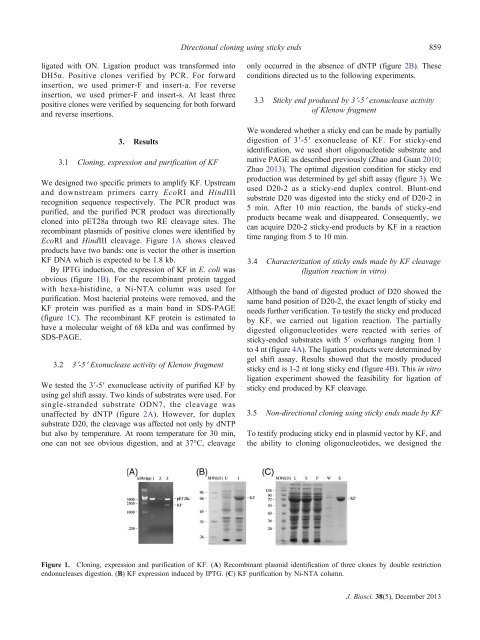Realizing directional cloning using sticky ends produced by 3′-5 ...
Realizing directional cloning using sticky ends produced by 3′-5 ...
Realizing directional cloning using sticky ends produced by 3′-5 ...
You also want an ePaper? Increase the reach of your titles
YUMPU automatically turns print PDFs into web optimized ePapers that Google loves.
Directional <strong>cloning</strong> <strong>using</strong> <strong>sticky</strong> <strong>ends</strong> 859<br />
ligated with ON. Ligation product was transformed into<br />
DH5α. Positive clones verified <strong>by</strong> PCR. For forward<br />
insertion, we used primer-F and insert-a. For reverse<br />
insertion, we used primer-F and insert-s. At least three<br />
positive clones were verified <strong>by</strong> sequencing for both forward<br />
and reverse insertions.<br />
3. Results<br />
3.1 Cloning, expression and purification of KF<br />
We designed two specific primers to amplify KF. Upstream<br />
and downstream primers carry EcoRI and HindIII<br />
recognition sequence respectively. The PCR product was<br />
purified, and the purified PCR product was <strong>directional</strong>ly<br />
cloned into pET28a through two RE cleavage sites. The<br />
recombinant plasmids of positive clones were identified <strong>by</strong><br />
EcoRI and HindIII cleavage. Figure 1A shows cleaved<br />
products have two bands: one is vector the other is insertion<br />
KF DNA which is expected to be 1.8 kb.<br />
By IPTG induction, the expression of KF in E. coli was<br />
obvious (figure 1B). For the recombinant protein tagged<br />
with hexa-histidine, a Ni-NTA column was used for<br />
purification. Most bacterial proteins were removed, and the<br />
KFproteinwaspurifiedasamainbandinSDS-PAGE<br />
(figure 1C). The recombinant KF protein is estimated to<br />
have a molecular weight of 68 kDa and was confirmed <strong>by</strong><br />
SDS-PAGE.<br />
3.2 <strong>3′</strong>-5′ Exonuclease activity of Klenow fragment<br />
We tested the <strong>3′</strong>-5′ exonuclease activity of purified KF <strong>by</strong><br />
<strong>using</strong> gel shift assay. Two kinds of substrates were used. For<br />
single-stranded substrate ODN7, the cleavage was<br />
unaffected <strong>by</strong> dNTP (figure 2A). However, for duplex<br />
substrate D20, the cleavage was affected not only <strong>by</strong> dNTP<br />
but also <strong>by</strong> temperature. At room temperature for 30 min,<br />
one can not see obvious digestion, and at 37°C, cleavage<br />
only occurred in the absence of dNTP (figure 2B). These<br />
conditions directed us to the following experiments.<br />
3.3 Sticky end <strong>produced</strong> <strong>by</strong> <strong>3′</strong>-5′ exonuclease activity<br />
of Klenow fragment<br />
We wondered whether a <strong>sticky</strong> end can be made <strong>by</strong> partially<br />
digestion of <strong>3′</strong>-5′ exonuclease of KF. For <strong>sticky</strong>-end<br />
identification, we used short oligonucleotide substrate and<br />
native PAGE as described previously (Zhao and Guan 2010;<br />
Zhao 2013). The optimal digestion condition for <strong>sticky</strong> end<br />
production was determined <strong>by</strong> gel shift assay (figure 3). We<br />
used D20-2 as a <strong>sticky</strong>-end duplex control. Blunt-end<br />
substrate D20 was digested into the <strong>sticky</strong> end of D20-2 in<br />
5 min. After 10 min reaction, the bands of <strong>sticky</strong>-end<br />
products became weak and disappeared. Consequently, we<br />
can acquire D20-2 <strong>sticky</strong>-end products <strong>by</strong> KF in a reaction<br />
time ranging from 5 to 10 min.<br />
3.4 Characterization of <strong>sticky</strong> <strong>ends</strong> made <strong>by</strong> KF cleavage<br />
(ligation reaction in vitro)<br />
Although the band of digested product of D20 showed the<br />
same band position of D20-2, the exact length of <strong>sticky</strong> end<br />
needs further verification. To testify the <strong>sticky</strong> end <strong>produced</strong><br />
<strong>by</strong> KF, we carried out ligation reaction. The partially<br />
digested oligonucleotides were reacted with series of<br />
<strong>sticky</strong>-ended substrates with 5′ overhangs ranging from 1<br />
to 4 nt (figure 4A). The ligation products were determined <strong>by</strong><br />
gel shift assay. Results showed that the mostly <strong>produced</strong><br />
<strong>sticky</strong> end is 1-2 nt long <strong>sticky</strong> end (figure 4B). This in vitro<br />
ligation experiment showed the feasibility for ligation of<br />
<strong>sticky</strong> end <strong>produced</strong> <strong>by</strong> KF cleavage.<br />
3.5 Non-<strong>directional</strong> <strong>cloning</strong> <strong>using</strong> <strong>sticky</strong> <strong>ends</strong> made <strong>by</strong> KF<br />
To testify producing <strong>sticky</strong> end in plasmid vector <strong>by</strong> KF, and<br />
the ability to <strong>cloning</strong> oligonucleotides, we designed the<br />
Figure 1. Cloning, expression and purification of KF. (A) Recombinant plasmid identification of three clones <strong>by</strong> double restriction<br />
endonucleases digestion. (B) KF expression induced <strong>by</strong> IPTG. (C) KF purification <strong>by</strong> Ni-NTA column.<br />
J. Biosci. 38(5), December 2013
















